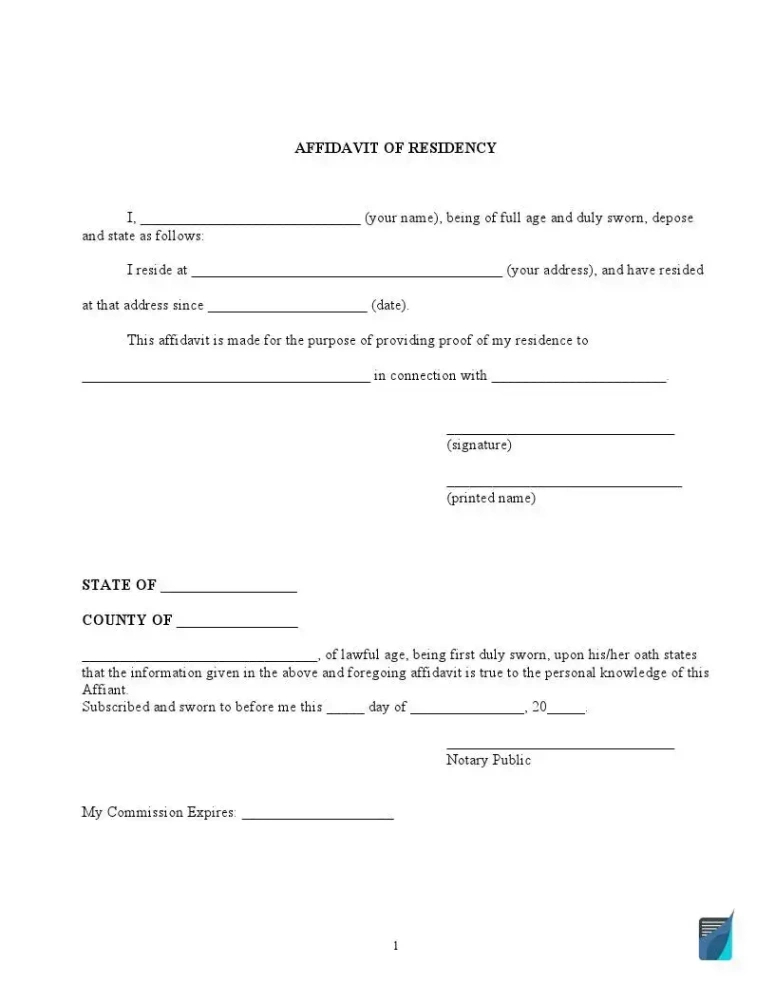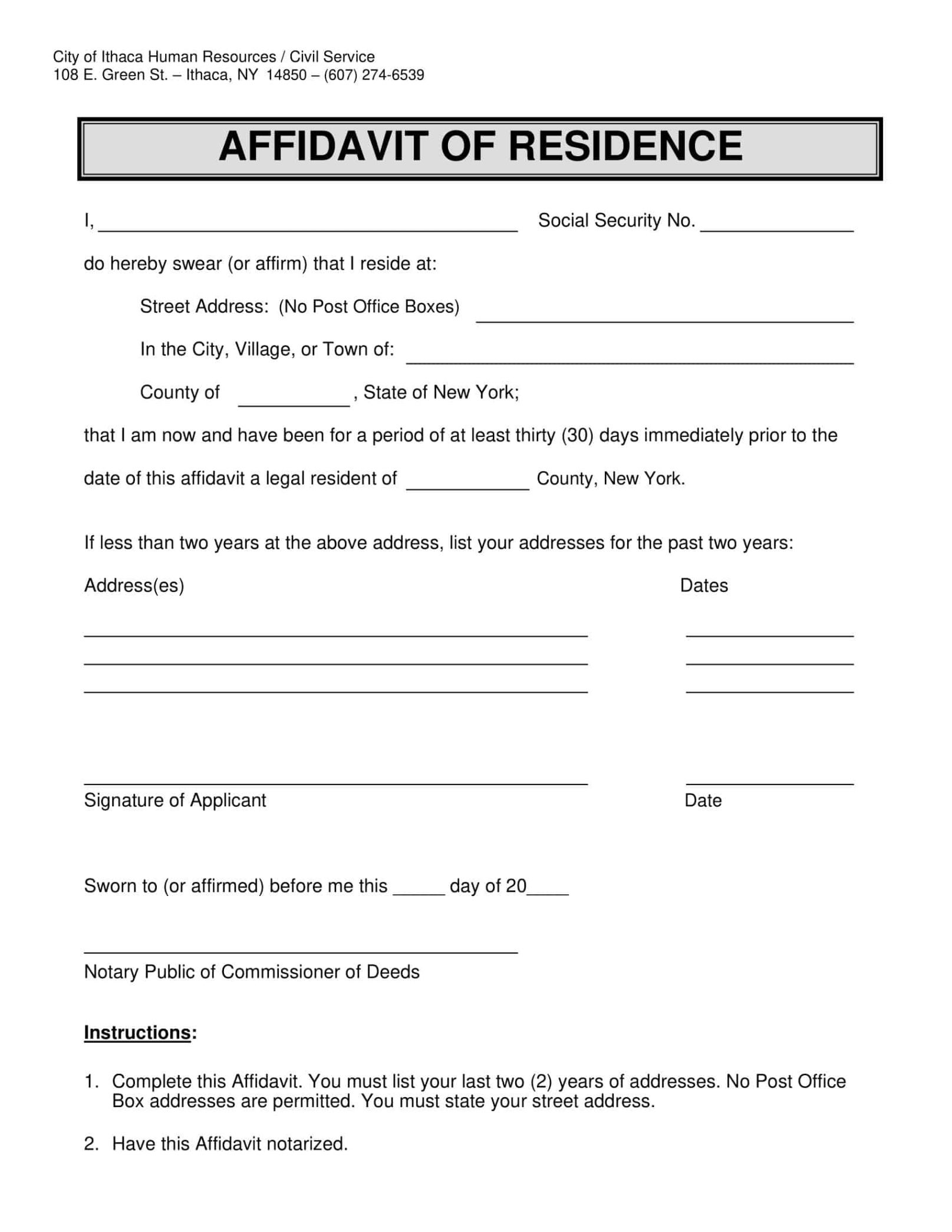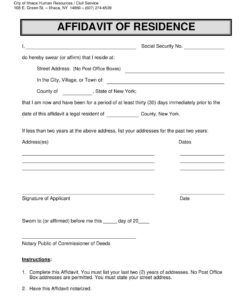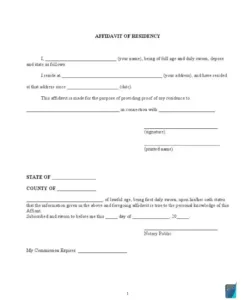Free blank landlord affidavit of residence template word -Need to swear something is true under oath, but feeling lost in legal jargon? No need to stress, you’re not alone! Sworn declarations can seem overwhelming, but they’re actually easier than they look once you know what’s required. Think of it as a formal, written statement of facts, used in official matters or other juridical contexts. The good news is, getting started doesn’t have to break the bank. In fact, a basic affidavit form is often free.
Essentially, an affidavit template offers a framework for you to fill in relevant information. It’s like having a ready-to-use outline for your legal declaration. This can be a major time-saver compared to writing it manually. It also helps prevent missing key details or using incorrect legal terminology. While a template is a solid first step, remember that your case may differ, so you might need to tailor the template to fit your specific needs.
Think of it this way: the document serves as the frame, and you are the builder. You’ll need to add the bricks and mortar of your personal story to create a solid and reliable structure. So, let’s walk through how to use a template the right way to create a clear and court-ready record. Getting familiar with the core concepts enables you to act with legal confidence.
At its core, an affidavit is a legally sworn document made with a formal vow. It’s a crucial legal document used in a variety of contexts, from legal hearings to commercial arrangements. The person making the statement is called the declarant, and they must swear or affirm that the contents of the affidavit are true to the best of their knowledge and belief. This legal promise adds a layer of formality to the statement, making it admissible as evidence in court. Affidavits are often used when a person is unavailable to testify live to give oral evidence, or when a written account is required.
A standard affidavit opens with a introductory label that identifies the document and the court or context in which it will be used. Following the title section, you’ll find the affiant’s (the person making the statement) identifying details, including their full name, address, and contact details. This information confirms who the affiant is and why they’re involved. It is important to ensure this information is accurate and current.
Most affidavits share a typical composition. It typically includes a heading, the affiant’s identity details, a statement of facts the affiant is attesting to, a certification section (where a notary confirms the statement was made under oath), and the affiant’s signature. The language used in the affidavit should be unambiguous, readable, and consistent. Remember, the goal is to communicate truth clearly and effectively.
[%Following the main content, you’ll find the notary clause, which is the part where you swear or affirm the truthfulness of your statements before a notary public or another authorized official. The jurat typically includes a [%statement like “Sworn to and subscribed before me this [date]”|phrase such as “Subscribed and sworn before me on [date]”|standard acknowledgment of oath and date%] and the notary’s signature and seal. The jurat is crucial because it makes the affidavit legally enforceable.|Obtaining a working affidavit template is relatively simple. Many websites offer a free affidavit template. It’s important to choose a template from a reputable source and make sure it fits your purpose. Once you have the template, you can adapt it with your specific details, such as the person’s name, signing date, and supporting facts. Be sure to write plainly and accurately, and avoid making any statements that are speculative or based on hearsay. A good affidavit is rooted in fact and personal knowledge.|If you’re relying on a pre-made form, it’s important to carefully review and adapt it to your specific needs. Don’t just blindly fill in the blanks. Ensure that the template contains each essential part and that the language accurately reflects your intended statement. It’s also advisable to check if your area’s notarization standards are met, as notary requirements can vary.|The typical structure of an affidavit includes these key elements. First, you introduce your identity and declare your purpose. Then, you lay out your statements factually and logically, limiting yourself to what you personally experienced. Finally, you finalize your statement with an oath before a legal officer, who then authenticates it with a stamp and signature. Using a template ensures all these elements are included properly.%]
When drafting your affidavit, being correct and easy to follow is essential. Double-check all the information to ensure that it is correct and complete. Use exact information and avoid unclear phrases or generalities. Organize your thoughts in a logical order, presenting the facts in a clear and easy-to-understand manner. And remember, if you’re uncertain about how to proceed, it’s always a good idea to get help from a legal expert.
Affidavit forms are not one-size-fits-all. Some are meant for specialized cases, while others are broad in structure. Consider the specific purpose of your affidavit and choose a template that matches your requirements. For instance, if you’re providing an affidavit in a child custody case, you’ll want a template that lets you explain how you know and care for the child, your notes on the child’s condition, and any concerns you may have. The right form helps avoid mistakes and improves clarity.
Note that using a template is merely the first step. You may need to modify the template to accurately reflect the specific facts of your case. Don’t be afraid to add or remove sections as needed. Just be sure to maintain the overall structure and integrity of the document. If you’re not comfortable making these modifications yourself, consider seeking assistance from an attorney or legal professional.
Keep in mind, while an affidavit template provides a useful framework, it’s not a substitute for legal advice. If you have any issues or hesitations about the content of your affidavit, reach out to a legal professional. An attorney can review your affidavit and advise you on any necessary revisions or additions. They can also represent you in legal proceedings and make sure the document is handled correctly.
The power of an affidavit lies in its truthfulness and clarity. By completing a form and sticking to these practices, you can draft a convincing and compliant statement that effectively presents your side of the story. An affidavit is a valuable tool in many legal situations. When completed correctly, it can serve as your voice when you aren’t able to be physically present. Investing effort into understanding it is worthwhile.
The image above posted by admin on July, 7 2025. This awesome gallery listed under Affidavit Templates category. I really hope you might enjoy it. If you would like to download the picture to your device in high quality, just right click on the picture and choose “Save As” or you can download it by clicking on the share button (X, Facebook, Instagram or Tiktok) to show the download button right below the image.



